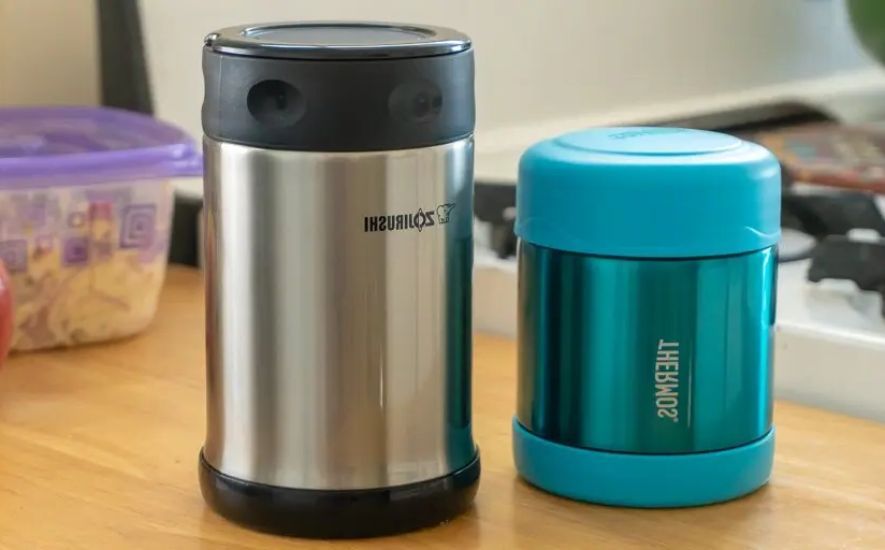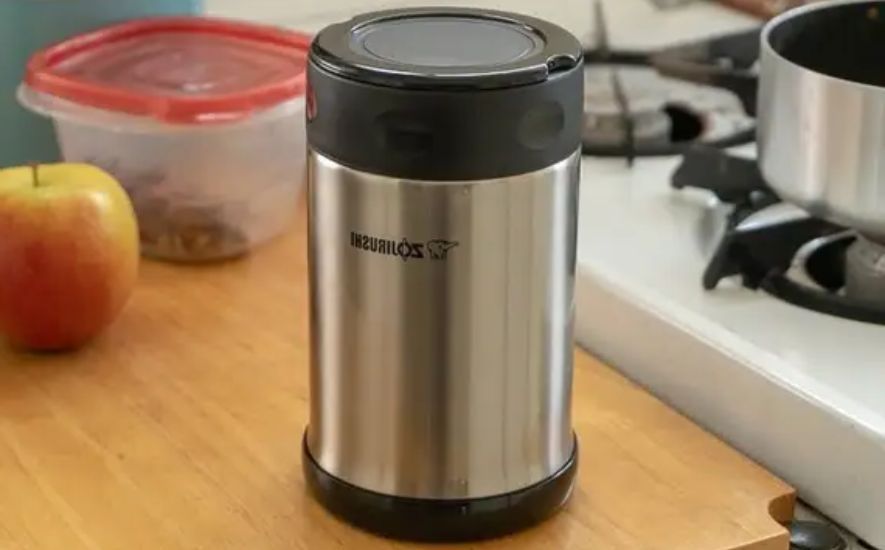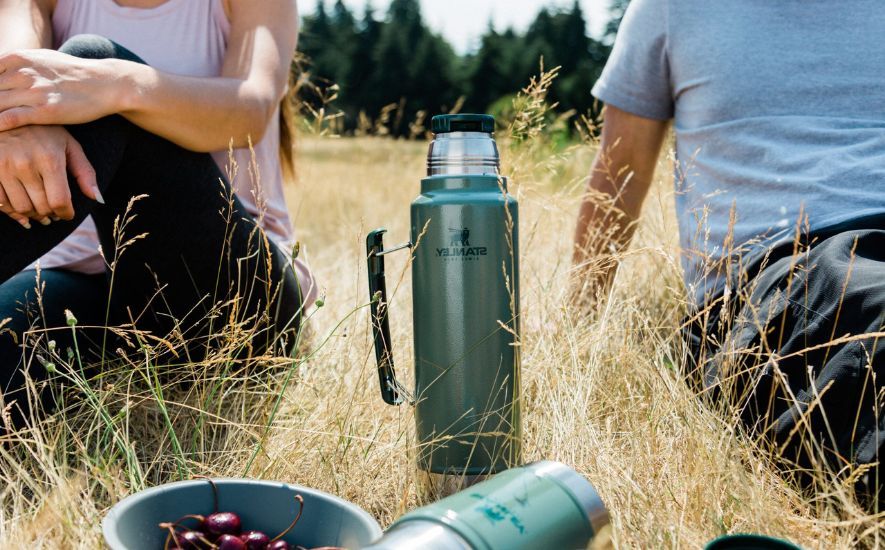In the realm of culinary experimentation, where the boundaries of conventional kitchen practices are constantly pushed, a peculiar inquiry beckons for attention: Can you microwave a thermos? Picture this: a realm where microwaves and thermoses coexist, where the hum of the microwave meets the quiet containment of a thermos, and where the laws of heat and insulation collide in a mesmerizing clash of wits.
Imagine, if you will, the unsuspecting adventurer standing before the kitchen counter, a glimmer of curiosity twinkling in their eyes. A steaming cup of coffee sits beside an empty thermos, mug, or jar, awaiting its turn in the spotlight. With a mischievous grin, the adventurer ponders the unthinkable: What would happen if the seemingly impenetrable fortress of a thermos were to face the fiery wrath of the microwave?
Join us on this electrifying journey as we embark on a scientific exploration of microwave and thermos compatibility. Brace yourself for a wild ride of heat, insulation, and unforeseen consequences. Welcome to the fascinating realm where culinary curiosity meets thermodynamic realities - the quest to discover whether or not you can truly microwave a thermos.

Microwave A Thermos Experiment: Microwaving for Thermal Madness
In the realm of kitchen adventures, a curious experiment exists that combines the wonders of microwaving with the enigmatic properties of a thermos. This unorthodox union, known as the "Thermos Experiment," promises to take your culinary escapades to new levels of thermal madness.

Unveiling the Science:
The Thermos Experiment revolves around the manipulation of heat transfer and insulation. The core idea is to place to use a thermos filled with liquid in a microwave oven.
By enclosing the liquid within the thermos, the aim is to harness the microwave's energy to heat the liquid in an unconventional manner, pushing the boundaries of culinary experimentation.
Microwaving with a Twist:
Microwaving a liquid within a thermos alters the typical heat distribution process. Unlike traditional microwave cooking, where the microwave energy directly heats the food, the thermos acts as a barrier, introducing an additional layer of complexity. The microwave's electromagnetic waves interact with the thermos, leading to a unique heat transfer dynamic.
Predicting the Outcomes:
The Thermos Experiment yields a range of possible outcomes, each brimming with suspense. While the specific results may vary depending on factors such as thermos material, microwave power, and liquid composition, here are a few potential scenarios:
a. Superheating Surprise: In some instances, the liquid inside the thermos may reach temperatures beyond its boiling point without actually boiling. This phenomenon, known as superheating, can create a precarious situation where the liquid appears calm but suddenly erupts when disturbed, posing a scalding risk.
b. The Thermos Dance: Due to the unique heat distribution, the thermos itself may become heated during the experiment. Handling the thermos immediately after microwaving can lead to unexpected burns, as its exterior might be much hotter than expected.
c. Culinary Curiosities: The Thermos Experiment also opens the lid to intriguing culinary possibilities. Different liquids, such as soups, stews, or beverages, may yield distinct results in terms of flavor and texture. Exploring this uncharted territory allows for a gastronomic adventure like no other.

Put A Thermos In The Microwave: Unveiling the Thermos Trials
The microwave oven has been a revolutionary appliance in modern kitchens, providing quick and convenient cooking options. However, recent developments have raised concerns regarding microwaves' safety and potential hazards.

I. The Microwave Myth:
Microwaves have long been considered a staple in kitchens worldwide, touted as a time-saving marvel that thermos food in seconds. This notion has perpetuated a myth that microwaving is a harmless cooking method. However, beneath this veneer of convenience lies a deeper truth that demands scrutiny.
II. The Thermos Trials Unveiled:
Heat up a Thermos, a clandestine scientific experiment, sought to examine the long-term effects of microwave usage on various materials, particularly those commonly used in food storage. The findings of this covert operation were shocking and sent ripples of concern through the scientific community.
III. Material Meld: A Closer Look at Plastics:
One of the key revelations from the Thermos Trials was the discovery of the adverse effects of microwaving plastic containers. While many plastic products claim to be "microwave safely," the trials exposed the hidden dangers of this widely accepted notion.
Under the intense heat generated by microwaves, certain plastic compounds undergo a process known as "material meld," wherein they release harmful chemicals into the food they come in contact with.
IV. Lethal Leakage: The Perils of Microwaves on Metals:
Another startling discovery from the Thermos Trials pertained to the interaction of microwaves with metals. Contrary to popular belief, when subjected to microwave radiation, certain metal objects can cause lethal leakage of electromagnetic waves. This phenomenon poses a grave risk to both the microwave user and the surrounding environment.
V. Cracking the Glass Code:
Glass has long been hailed as a safe alternative to plastics for microwave use. However, the Thermos Trials uncovered an alarming vulnerability in glass containers.
The intense thermal stress caused by microwaving can result in microscopic cracks forming within the glass, rendering it fragile and prone to shattering. This poses a physical hazard and introduces the potential for glass fragments to contaminate the food.

Microwave vs. Thermos: The Clash of Heat and Insulation
In the ever-evolving world of modern kitchen appliances and tools, two champions stand tall when it comes to heat management: the microwave and the thermos. These two inventions have revolutionized the best way to heat and insulate our food and beverages and keep the food warm.

While they both serve similar purposes, they do so in vastly different ways. Join us as we delve into the clash of heat and insulation, exploring the unique qualities and functionalities of the microwave and thermos.
The Microwave: Lightning-fast Heatwaves
The microwave, a staple in most modern kitchens, has become synonymous with quick and convenient heating. It utilizes electromagnetic waves to generate heat directly within the food or liquid being heated. The key to its speed lies in the microwaves' ability to penetrate food or liquid, exciting water molecules and creating friction that generates heat.
- The Science Behind Microwave Heating:
Microwaves operate at a frequency of approximately 2.45 gigahertz, specifically targeting water molecules due to their polar nature. As the microwaves pass through the food or liquid, the water molecules vibrate rapidly, generating heat from within. This process ensures that the heat is distributed evenly, providing efficient and rapid heating.
- Pros and Cons of Microwave Heating:
The microwave's speed and convenience make it a popular choice for quick meals and beverages. It can defrost frozen foods, reheat leftovers, and even cook entire meals in a matter of minutes.
However, there are limitations to its effectiveness. Microwaves may not always heat food uniformly, resulting in hot spots or unevenly warmed dishes. Additionally, certain materials, such as metal, cannot be used in microwaves because they may cause sparks.
The Thermos: Guardian of Warmth
While the microwave focuses on heating, the thermos takes on the crucial task of insulation. It is a vessel designed to maintain its contents' temperature, keeping hot and cold liquids cold for extended periods. The secret lies in its construction, which utilizes a combination of materials to create an effective barrier against thermal energy transfer.
- The Inner Workings of a Thermos:
A typical thermos consists of three key components: an outer container, an inner container, and a vacuum layer in between. The inner container, usually made of glass or stainless steel, holds the liquid and is surrounded by a vacuum layer, which is crucial for insulation. The outer container acts as an additional layer of protection, reducing heat transfer through conduction.
- The Power of Insulation:
The vacuum layer within the thermos prevents heat transfer through conduction or convection. Without any air or gas molecules present to facilitate the transfer of heat, the thermos effectively traps the temperature of the liquid inside, be it hot or cold. This insulation allows users to enjoy their desired beverage at the desired temperature, even hours after it was initially poured.
The Clash: Finding Common Ground
While the microwave and thermos serve different purposes, they intersect in one crucial aspect: convenience. Both appliances cater to our fast-paced lifestyles, providing efficiency and ease of use. Combining their powers can result in the perfect balance of heating and insulation.
- The Microwavable Thermos:
In recent years, a new innovation has emerged—a microwavable thermos. This hybrid appliance takes advantage of both technologies, allowing users to heat their beverages or food in the microwave and then transfer them to the thermos for long-lasting warmth. This fusion of convenience and insulation offers the best of both worlds, ensuring hot food or drinks throughout the day.
- Embracing the Diversity:
While the microwave and ceramic thermos have unique strengths, embracing their diversity and selecting the appropriate tool for each situation is essential. The microwave shines brightly for quick heating, while the thermos excels in preserving temperatures over time. We can harness their collective power to suit our heating and insulation needs by understanding their differences.
Frequently Asked Questions (FAQs)
This FAQ will address this query and provide insights into the potential risks and considerations associated with microwaving a thermos. By understanding the guidelines and precautions, you can make informed decisions about using your thermos in the microwave.
Can you warm up a thermos?
Absolutely! Warming up a thermos is a delightful way to keep your favorite beverages at the perfect temperature. Just imagine, on a chilly morning, you can cozy up with a steaming cup of hot chocolate, brewed coffee, or even a soothing herbal tea. To warm up your thermos, fill it with boiling water and let it sit for a few minutes.
This allows the thermos to absorb the heat and create a snug environment for your drink of choice. Remember to pour out the hot water before adding your desired beverage, and voila! Your thermos is now ready to keep your drink wonderfully warm for hours on end.
Are thermos products microwave-safe?
Ah, the magic of microwave ovens! While thermos products are designed to retain heat, it's essential to note that they are not typically microwave safe. Microwaving a thermos can lead to unwanted consequences, such as a build-up of pressure within the container or even damage to the thermos itself.
It's best to avoid subjecting your thermos to the microwave's radiant energy. Instead, consider using a microwave-safe container to heat your beverage separately and then transfer it to your trusty thermos. This way, you can enjoy the benefits of both technologies while keeping your drinks piping hot or refreshingly cool.
Can you heat up a stainless steel thermos?
Indeed, you can heat up a stainless steel thermos with a touch of finesse. Stainless steel thermoses are renowned for their durability and insulation properties, making them a fantastic choice for keeping your drinks at the desired temperature.
When it comes to heating up a stainless steel thermos, it's crucial to exercise caution. Avoid direct exposure to open flames or high heat sources, as this may cause damage.
Instead, fill your thermos with your desired hot beverage, ensuring it's at the desired temperature before pouring it in. The stainless steel construction will help retain the heat, ensuring your drink remains warm and delightful for hours to come.
Conclusion
In conclusion, the enigmatic realm of ways to heat a thermos container leaves us with a curious blend of caution and curiosity. While conventional wisdom discourages such adventurous endeavors, the daring few embark on the less traveled path.
In this realm of culinary exploration, we find ourselves teetering on the precipice of discovery and danger. Whether the thermos succumbs to the wrath of electromagnetic waves or emerges unscathed as a beacon of resilience, the microwave remains uncharted territory for the thermic voyage.
So, as the culinary pioneers of tomorrow, we must tread lightly, armed with knowledge, and ready to embrace the unexpected consequences that lie within the humming confines of the microwave oven.










